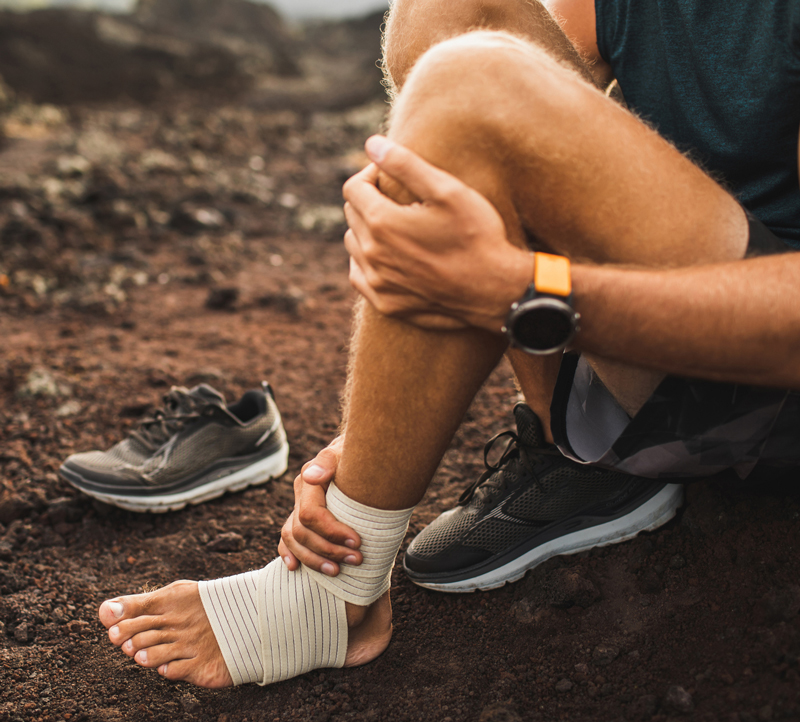
iStockphoto.com #1163253873
By Keith Loria
Lateral ankle sprain is the most common injury in physically active populations, yet some believe those who sustain an acute lateral ankle sprain may not receive timely formal rehabilitation and are at an increased risk to have subsequent sprains which can lead to chronic pain and instability.
That led Bradley Wells, PT, DSc, SCS, a physical therapist at Naval Hospital Camp Lejeune, to conduct a study, “Management of Acute Grade II Lateral Ankle Sprains with an Emphasis on Ligament Protection: A Descriptive Case Series,” which was part of a research project he performed to complete his Doctor of Science from Baylor University. The publication appeared in the International Journal of Sports Physical Therapy.
“The initial goals were to evaluate the current state of literature surrounding management of lateral ankle sprains and consider a novel approach in the management of this injury which has a rather high recurrence rate,” he says. “Athletes typically return to sport within 10 days, well before full recovery and approximately 70% of patients report subsequent ankle sprains within one year of their initial injury, and 45% report incomplete recovery three years after injury.”
For his study, 10 patients (mean age 26.7 years, range 16-51 years, mean 2.3 days from injury) with acute grade II lateral ankle sprain were treated with an approach to protect the injured ligament, prevent impairments to movement, restore strength and proprioception, and progress to full function.
“Consecutive patients with acute primary grade II lateral ankle sprains either referred from the local emergency department or a direct access physical therapy clinic were consented and enrolled if they met the inclusion criteria,” Wells said. “Upon enrollment, each subject underwent a patient-focused interview to determine the location and behavior of symptoms in addition to relevant details of the current injury and any previous injuries and existing conditions.”
Following the interview, each patient received a thorough examination of the lower quarter and were treated with an approach focused on individual impairments. Outcomes included the Foot and Ankle Ability Measure, Activities of Daily Living, Numeric Pain Rating Scale (NPRS), Ankle Lunge Test, and Y-Balance Test, which were collected at 4, 8, and 12 weeks along with a follow up phone interview at the 6- and 12-month mark to assess for re-injury.
 “The major takeaway is that a lateral ankle sprain is a ligamentous injury and should be managed accordingly,” Wells said. “By limiting inversion for 6 weeks and prescribing prolonged bracing for 12 weeks, the lateral ligament complex was allowed appropriate time to heal and protected against overly straining forces. In the end, all patients regained full ROM which held through the 1-year mark, and 9 out of 10 patients reported no recurrence of sprain.”
“The major takeaway is that a lateral ankle sprain is a ligamentous injury and should be managed accordingly,” Wells said. “By limiting inversion for 6 weeks and prescribing prolonged bracing for 12 weeks, the lateral ligament complex was allowed appropriate time to heal and protected against overly straining forces. In the end, all patients regained full ROM which held through the 1-year mark, and 9 out of 10 patients reported no recurrence of sprain.”
The key treatment principles, he explained, were protecting the ankle joint through bracing and by limiting ankle inversion, promoting frequent dorsiflexion and a normal gait to stimulate ligament healing and maintain ankle movement, and providing individual patient tailored manual therapy and return-to-function treatment programs.
“Use of these balanced strategies to manage acute grade II ankle sprains may promote ankle stability, prevent impaired ankle movement, reduce rates of re-injury, and improve functional outcomes,” Wells said. “These findings are important because they suggest that early implementation of a comprehensive strategy prioritizing joint protection while preventing movement impairments may improve primary ankle sprain outcomes.”
While the application of this case series is quite simple, the injury itself is complex. Therefore, Wells recommended that clinicians limit ankle inversion for 6 weeks and use a lace-up brace for 12 weeks, then after 12 weeks wear the brace as needed with physical activity, sport, or any time there is an increased risk of injury.
“Treat the patient using an impairment-based approach, focusing on restoring ankle dorsiflexion, as this ROM has been shown to be a predictor of future injury if not restored,” Wells said. “Lastly, manage ankle sprains with an approach that is consistent with ligamentous injury.”
For example, controlled ROM through bracing is a foundational strategy for managing a tear to the medial collateral ligament of the knee. This protects the healing joint, promotes regular arrangement of healing fibers and limits disruptive valgus force.
“In contrast, when the anterior talofibular ligament of the ankle is injured in a lateral ankle sprain, patients are typically braced for short periods and given exercises that encourage repeated inversion potentially overly stressing and stretching healing tissue,” Wells said. “There is a predictable healing pathway after ligamentous injury that includes an inflammatory phase, proliferative phase, and a remodeling phase that increases tensile properties; this healing process should influence the clinical decisions being made when working with patients with acute lateral ankle sprains.”
Keith Loria is a Washington DC-based freelance writer
Source: Well B, Allen C, Deyle G, Croy T. Management of acute grade II lateral ankle sprain with an emphasis on ligament protection: a descriptive case series. Int J Sports Phys Ther. 2019;14(3):445-458.










Trackbacks/Pingbacks